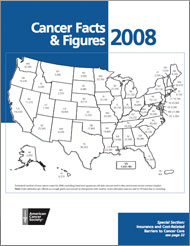Cancer Facts & Figures 2008

The 2008 edition of Cancer Facts & Figures provides the estimated numbers of new cancer cases and deaths in 2008 as well as cancer incidence, mortality, and survival statistics and information on cancer symptoms, risk factors, early detection, and treatment. About 1,437,180 new cancer cases were expected to be diagnosed in 2008, and in 2008 about 565,650 Americans were projected to die of cancer, more than 1,500 people a day. (Please note: The projected numbers of new cancer cases and deaths in 2008 should not be compared with previous years to track cancer trends because they are model-based and vary from year to year for reasons other than changes in cancer occurrence. Age-standardized incidence and death rates should be used to measure cancer trends.)
Cancer Facts & Figures 2008: Special Section
The topic of the special section of Cancer Facts & Figures 2008 is insurance and cost-related barriers to cancer care. For many cancer patients, health insurance status and other financial barriers delay or limit access to treatment and supportive services, and for almost all patients, cancer treatment presents a significant financial burden. In this section, you’ll find an overview of systems of health insurance in the United States, and the impact of being uninsured or underinsured on cancer prevention, diagnosis, treatment, and outcomes.
Please Note: Change in Methodology for 2008
Beginning with Cancer Facts & Figures 2007, estimated new cancer cases in the current year were computed using a new, more accurate method developed by researchers at the National Cancer Institute and the American Cancer Society. Improvements in the new model include use of data from a much larger percentage of the US population, allowance for geographical variation in cancer incidence, adjustment for delays in reporting, and the inclusion of many socio-demographic, medical facility, lifestyle, and cancer screening behavior variables. Comparisons of estimates produced by the old and new methods were generally similar for all cancers combined but differ substantially for some sites.
2008 Method for Estimating Incidence
For more information regarding the new method for estimating incidence, see the following documents:



